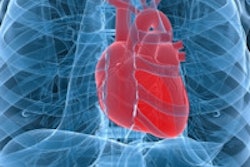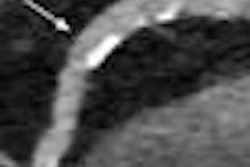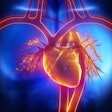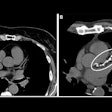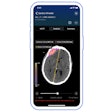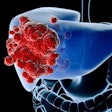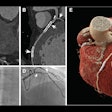A new study in Radiology concludes that coronary CT angiography (CCTA) can predict adverse coronary events not only in patients with risk factors for heart disease, but also in those without such factors. The results suggest a more prominent role for CCTA versus using clinical risk scores to predict heart disease risk.
Coronary disease is common among patients traditionally considered to be at low risk, "with significantly increased hazards for [major adverse cardiac events (MACE)] and mortality," concluded lead investigator Dr. Jonathon Leipsic, from St. Paul's Hospital and the University of British Columbia, and colleagues (Radiology, February 19, 2013).
Notably, the risk correlated with CT results fairly evenly across the board, regardless of demographics or symptoms, Leipsic said in an interview with AuntMinnie.com.
"We found that obstructive coronary artery disease predicts major adverse cardiac events, both with 'soft' end points such as late revascularization or urgent revascularization, as well as 'hard' end points such as [myocardial infarction (MI)] or death across both asymptomatic and symptomatic patients without modifiable cardiovascular risk factors," Leipsic said.
Clinical risk scoring
Currently, referral to noninvasive testing for people with suspected coronary artery disease (CAD) depends in part on scoring of clinical risk factors. Those who are free of risk factors are thought to be at very low risk, but the true prevalence of disease is unknown, wrote Leipsic and colleagues Dr. Carolyn Taylor and Gilat Grunau, PhD.
The study is a subanalysis of the prospective, multinational CT Angiography Evaluation for Clinical Outcomes (CONFIRM) trial to evaluate the prevalence, extent, severity, and risk of CAD in individuals without modifiable risk factors for heart disease.
From an international cohort of 27,125 subjects in 12 centers in the U.S., Europe, and Asia who participated in CONFIRM, the researchers identified 5,262 patients without known CAD and without modifiable risk factors.
Based on CCTA results, the researchers stratified CAD severity as none (0% luminal narrowing), mild (1% to 49% luminal narrowing), or obstructive (≥ 50% narrowing) on a per-patient, per-vessel, and per-segment basis. They then aimed to link the presence and severity of coronary artery disease to the incidence of MACE using a Cox proportional hazards analysis.
Patients with known medically modifiable CAD risk factors, including diabetes, hypertension, dyslipidemia, and smoking, were excluded from the analysis, and all patients included were referred for the exclusion of CAD based on symptoms or clinical concern that was often attributed to a family history of coronary disease, the authors wrote.
Chest pain was categorized according to the classic criteria for angina pectoris, and it was evaluated based on the results of a written questionnaire or an interview by a medical professional. Scans were acquired on single- or dual-source CT scanners with 64 or more detector rows and were evaluated by highly experienced readers. Outcomes and mortality were assessed after a mean 2.3 years of follow-up.
The researchers discovered that evidence of disease was common, with 1,452 (27%) patients having evidence of nonobstructive disease and 629 (12%) patients showing evidence of obstructive coronary artery disease.
Major adverse cardiac events had occurred in 106 of the 5,262 patients, which included 62 patient deaths. But patients with findings of no disease at CCTA had a very low annualized rate of MACE, at 0.31%, compared with a rate of 2.06% in patients who had obstructive disease on CCTA. The presence of major events was associated with increased patient age, more frequent angina symptoms, and a pretest likelihood of CAD.
The length of time to the adverse events was a matter of CAD degree as well, predicted by the maximal per-patient obstructive CAD for both univariable and multivariable Cox regression analysis considering age and sex. And the per-vessel assessment of obstructive disease showed a dose-response relationship for increased risk of MACE for one-vessel, two-vessel, and three-vessel or left main disease (p ≤ 0.001 for all three statuses). Those patients suffering adverse events had a greater number of coronary segments with obstructive disease than those without MACE. Finally, patients who died were more likely to have proximal rather than distal coronary artery disease.
While obstructive CAD was associated with MACE incidence in both symptomatic and asymptomatic individuals, nonobstructive CAD was associated with incidence of MACE in only symptomatic individuals and not asymptomatic individuals, Leipsic and colleagues wrote. However, obstructive disease was documented more frequently in those with a family history of premature CAD (p ≤ 0.001).
The presence of increasing coronary artery disease burden was predictive of MACE at the per-patient, per-vessel, and per-segment level across varying symptom and family history status, with differential risk observed in accordance to pretest likelihood of CAD as well as older age, the study team wrote.
"Notably, we observed a relationship of increased CAD burden to all individual 'hard' end-point components of MACE, including death, myocardial infarction, and late target vessel revascularization."
Real-world registry
While the findings should be considered highly generalizable, it's important to recognize that the patients are part of a real-world cardiac registry database with a certain proportion of individuals who were scanned without support of clinical guidelines -- and this study is the first to look at such a population, the group wrote.
"We're not advocating screening, but I do think that it highlights the real power of CCTA in patients who present with symptoms, atypical and otherwise; that doctors cannot rely on the presence or absence of diabetes, or the presence or absence of hypertension to predict whether that patient is at risk, and then just dismiss them based on the fact that the symptoms are atypical and they don't have risk factors," Leipsic said. "CT is a very powerful tool to identify those at risk from those not at risk, and I think that's the take-home point: Don't rely on these clinical risk factors to determine who is likely or unlikely to have coronary disease, just do the simple test that answers that question."
The study came with a few limitations, including the presence of referral bias, and the findings, "while provocative, cannot allow for cause-effect conclusions," the authors wrote. In any case, the results suggest the need to refine the evaluation of individuals whose disease may be missed by traditional methods of evaluating disease risk.
The results also support the use of CCTA as a potentially effective method to discriminate those who have coronary disease from those who don't, and future prospective studies to address the findings appear warranted. New algorithms will be essential because for now there's no way to measure the risk in these individuals.
"Often you don't really know what to do with these patients, and I think CT is allowing us to understand better who's a real risk, not just for having a heart attack but even dying, as we've seen in our analysis," Leipsic said.
For that matter, even the risk-scoring methods in patients with modifiable risks aren't used as they were intended.
"For example, Framingham [risk score] is for an asymptomatic population and the assessment of lifetime risk -- and if we use something like the Diamond-Forrester [pretest probability method], that's not really a predictor of events, so much as it is to predict the likelihood of obstructive coronary disease," Leipsic said. Now, with the large CONFIRM database available for analysis, "we're going to be able to develop risk scores to better identify patients when they present."
The results also highlight an important point that's been consistent over a number of patient populations: the more coronary artery disease demonstrated at CCTA, the worse patients do, he said.





